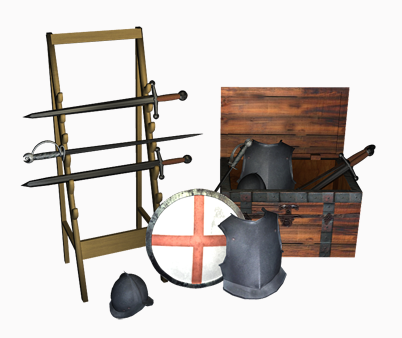Object Descriptions Tower House Storage Room and Armory
Weaponry
Spenser was known for his experience in several wars. His reputation in this regard helped secure him the nomination of Sheriff of Cork soon before his death. The Munster planters were responsible, in part, for their own security, including supplying able-bodied men and equipment for militias in time of need. Many weapons would have been stored in secure levels of a tower house, including areas like this one between main floors.
Estates would often have had their own smithies and carpentries that could have made weapons, farm and household goods.
Literary Connections
The Faerie Queene is full of weapons used for fighting on foot and horseback. In a few cases, we learn about weapons manufacture. Book I.i.8-9 presents a Virgilian catalog of trees described according to their industrial, medicinal and folkloric uses. We read this catalog when the hero of Book I, Red Crosse Knight, and his lady Una are caught by a rainstorm and enter into a forest for shelter at the very beginning of the epic:

And foorth they passe, with pleasure forward led,
Ioying to heare the birdes sweete harmony,
Which therein shrouded from the tempest dred,
Seemd in their song to scorne the cruell sky.
Much can they praise the trees so straight and hy,
The sayling Pine, the Cedar proud and tall,
The vine-propp Elme, the Poplar neuer dry,
The builder Oake, sole king of forrests all,
The Aspine good for staues, the Cypresse funerall.The Laurell, meed of mightie Conquerours
And Poets sage, the Firre that weepeth still,
The Willow worne of forlorne Paramours,
The Eugh obedient to the benders will,
The Birch for shaftes, the Sallow for the mill,
The Mirrhe sweete bleeding in the bitter wound,
The warlike Beech, the Ash for nothing ill,
The fruitfull Oliue, and the Platane round,
The caruer Holme, the Maple seeldom inward sound. (FQ I.i.8-9)
The trees listed here have both positive and negative uses and connotations. It is possible that the “Aspine good for staues” refers to barrel staves, but it might also refer to weapon “staves” (such as those held by Irish-looking villains in FQ II.ix.13.7).
Images of violence and warfare are clustered in the second stanza in particular: laurel for crowning “mightie Conquerors,” the yew (“Eugh”) for bows, myrrh with its “bitter wound” (an apparent allusion to myrrh’s association with the crucified Christ in the Bible, Mark 15.23), the birch for arrow “shaftes,” and the beech for “war” chariots (cf. Homer’s Iliad 5.839). Spenser opens his epic with images of trees fashioned for heroic and deadly uses.
Bibliography:
Andrew Hadfield, Edmund Spenser: A Life (Oxford: Oxford UP, 2012): 201, 220.
A. C. Hamilton (ed.), The Faerie Queene. By Edmund Spenser. 2nd ed. rev. (Harlow: Pearson, 2007), 33-4n.
Thomas Herron, “‘Goodly Woods’: Irish Forests, Georgic Trees in Books I and IV of Edmund Spenser’s Faerie Queene.” Quidditas: JRMMRA 19 (1998), 97-122.
Peter Rieman, “Silvan Matters: Error and Instrumentality in Book I of The Faerie Queene.” Spenser Studies 28 (2013), 119-43.
Colin Rynne, “The social archaeology of plantation-period ironworks in Ireland: immigrant industrial communities and technology transfer, c.1560-1640.” Plantation Ireland: Settlement and Material culture, c. 1550-c. 1700 (Dublin: Four Courts Press, 2009), 248-64.
Michael West, “Spenser’s Art of War: Chivalric Allegory, Military Technology, and the Elizabethan Mock-Heroic Sensibility.” Renaissance Quarterly 41 (1988), 654-704: 663-4.
Links:
http://folgerpedia.folger.edu/Now_Thrive_the_Armorers:_Arms_and_Armor_in_Shakespeare [accessed 2/22/16]
[Folger Shakespeare Library exhibit on arms and armor]